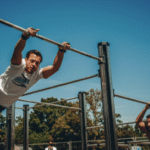The Science Behind Calisthenics Training
Calisthenics is a scientifically validated form of resistance training that uses the body’s own weight to build strength, muscle mass, endurance, and functional capacity. Far from being a random collection of exercises, modern calisthenics training relies on precisely manipulating leverage and physics to achieve progressive overload —the key mechanism for muscle adaptation and growth.
For Houstonians, understanding this science allows for efficient training anywhere, bypassing the need for heavy, external gym equipment.
- The Core Mechanism: Progressive Overload
The principle of progressive overload states that for a muscle to grow stronger (hypertrophy), it must constantly be challenged by an increasing stimulus. Calisthenics achieves this not by adding weight plates, but by systematically changing the leverage and stability of the exercise.
Manipulating Leverage: By shifting the body’s center of gravity, you change the amount of force the muscle must exert.
Example (Pushing): Moving from an incline push-up (which uses a small percentage of your body weight) to a standard push-up (a higher percentage) and finally to a one-arm push-up (nearly 100% of your body weight on one arm) ensures continuous progressive tension on the muscle.
Increasing Stability/Time Under Tension (TUT): Advanced calisthenics skills accelerate growth by demanding extreme stability and control.
Example: Exercises on gymnastic rings (like the ring dip) are harder than on solid parallel bars because the body must recruit countless small stabilizing muscles to control the movement. This instability and the requirement for slower, controlled reps maximize the Time Under Tension (TUT) , which is a major driver of muscle hypertrophy.
- Physiological Drivers of Muscle Growth
Calisthenics induces muscle growth through three primary physiological pathways, similar to weightlifting:
Mechanical Tension: Achieved through challenging progressions and isometric holds (like the plank, L-Sit, or Front Lever). This high tension signals the body to adapt by strengthening muscle fibers.
Muscular Damage: Micro-tears in muscle tissue, particularly during the eccentric (lowering) phase of movements like slow pull-ups or dips. This damage triggers the body’s repair process, resulting in stronger, larger muscle fibers.
Metabolic Stress: Achieved through high volume circuit training (common in Houston’s functional fitness studios). Performing many repetitions with short rest periods causes a buildup of metabolic byproducts (lactic acid), leading to the “pump” effect. This swelling of muscle cells stimulates the release of growth factors.
- Functional Strength and Joint Health
Calisthenics offers superior functional strength compared to isolated machine work, directly benefiting a person’s quality of life and physical resilience.
Compound Movements: Calisthenics relies on compound movements (like the squat, pull-up, and muscle-up) that train the body as a single, integrated kinetic chain . This strengthens the coordination between muscle groups, which is essential for real-world activities (lifting, running, stabilizing the body).
Core Integration: Every calisthenics skill—from a push-up to a handstand—requires maximal core activation for spinal stabilization (anti-extension). This builds a resilient core that improves posture and protects against chronic back pain, a common issue for Houstonians with long commutes.
Joint Resilience: Since the weight is controlled, calisthenics is inherently low-impact. The focus on mobility drills and slow movements helps strengthen the tendons, ligaments, and supporting muscles around major joints (shoulders, elbows, wrists), effectively “bulletproofing” the body against injury
- Mental and Cognitive Benefits
The scientific benefits extend to the brain, making it an excellent practice for stress management.
Proprioception and Balance: Mastering skills like the handstand dramatically improves proprioception (the body’s awareness of its position in space) and balance. This enhanced cognitive control translates into better coordination and reduced risk of accidental falls.
Mental Toughness: The intense focus required for isometric holds and complex skill progressions acts as a form of active meditation . It enhances mental clarity, reduces stress, and builds the discipline and patience needed for long-term consistency.

The Science Behind Calisthenics Training
Route
Calisthenics Gym Houston Functional Bodyweight Training
Secondary phone: (346) 483-3195
Email: info@calisthenicsclubhouston.com
URL: https://calisthenicsclubhouston.com/
Monday 6:00 AM - 7:00 PM Tuesday 6:00 AM - 7:00 PM Wednesday 6:00 AM - 7:00 PM Open now Thursday 6:00 AM - 7:00 PM Friday 12:00 PM - 6:30 PM Saturday 9:45 AM - 12:00 PM Sunday 3:00 PM - 5:00 PM





